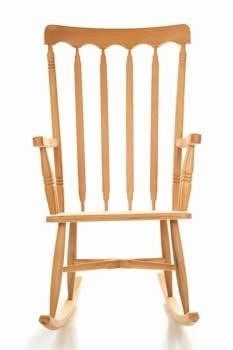Sam Maloof, a giant in American studio furniture, crafted iconic rocking chairs. His designs, a blend of modern and traditional, showcase skilled labor and organic forms. Maloof’s sought-after pieces are renowned for beauty, comfort, and exceptional artistry, embodying a legacy of handcrafted elegance.
Sam Maloof⁚ A Pioneer of American Studio Furniture
Sam Maloof, born into a Lebanese immigrant family in California, emerged as a guiding force in the American Studio furniture movement. He championed handcrafted pieces during the postwar era, rejecting mass-produced, synthetic furnishings. Maloof’s work, alongside figures like George Nakashima, revitalized craftsmanship and celebrated skilled labor. His designs offered a modern take on traditional furniture, especially seating and cabinetry. He brought a unique artistic vision to furniture making, emphasizing organic forms and seamless integration of parts. Maloof’s creations, especially his rocking chairs, are distinguished by their graceful lines and sculptural elements. His approach was deeply personal, aiming to create beautiful, functional objects for individuals he knew. This dedication to both art and personal connection set him apart. Maloof’s influence has left an indelible mark on American furniture design, solidifying his status as a true pioneer and master craftsman. His legacy continues to inspire furniture makers today, highlighting the beauty of handmade furniture.
The Legacy of Maloof’s Handcrafted Furniture
Sam Maloof’s legacy extends far beyond his lifetime, with his handcrafted furniture, particularly his rocking chairs, becoming cherished heirlooms for generations. His designs, often referred to as the “Maloof style,” feature lean, graceful lines, sculpted parts, and joints that emphasize both beauty and strength. Maloof’s pieces are not just functional; they are works of art, sought after by collectors and displayed in major museums. His approach to woodworking, focusing on individual pieces rather than mass production, has inspired countless artisans. Maloof’s commitment to creating furniture that contributed beauty and utility to everyday life resonates deeply. The enduring appeal of his style is evident in the continued interest in his pieces and the numerous attempts to replicate his designs. His influence on contemporary woodworking is undeniable, with many modern designers drawing inspiration from his organic forms and meticulous craftsmanship. The legacy of Maloof ensures his place as a seminal figure in American craft history.

Key Features of Sam Maloof Rocking Chairs
Maloof’s rocking chairs are defined by their sculpted forms and meticulous joinery. The curves, contoured seats, and flowing lines create a harmonious blend of comfort and aesthetics. Each chair stands as a testament to Maloof’s innovative design principles;
Distinctive Design Elements⁚ Curves and Joinery
Sam Maloof’s rocking chairs are immediately recognizable for their sensuous curves and masterful joinery. The flowing lines, from the scooped headrest to the sweeping rockers, are not merely aesthetic choices; they are integral to the chair’s comfort and structural integrity. Maloof’s approach to woodworking emphasized the natural beauty of the wood, allowing the grain and texture to enhance the overall design. The seamless blending of parts, where each component transitions gracefully into the next, showcases his exceptional skill. His joinery, often exposed, is not hidden but rather celebrated as a decorative element, demonstrating both strength and artistry. Each joint is meticulously crafted, ensuring durability and adding to the chair’s visual appeal. The use of curved laminations and contoured shapes further highlights the organic nature of his designs. These elements are not just functional; they contribute to the chair’s artistic expression and its enduring appeal. Maloof’s distinctive design is not formulaic, yet it always embodies his commitment to creating both beautiful and functional pieces of furniture, marking his pieces as iconic and highly sought after;

Materials and Construction Techniques
Sam Maloof’s masterful use of materials and construction techniques is a cornerstone of his iconic rocking chairs. He favored hardwoods like walnut, maple, and oak, chosen for their strength, beauty, and workability. Maloof personally selected each piece of wood, ensuring it met his exacting standards. His construction methods were rooted in traditional woodworking practices, but he also embraced innovative techniques to achieve his signature curves and seamless joinery. Lamination was frequently employed to create the flowing lines of the rockers and armrests, allowing for greater flexibility in design. Hand-shaping, often using a band saw and hand tools, was crucial in achieving the sculpted forms. Exposed joinery, such as mortise and tenon and dovetails, not only provided robust connections but also served as an aesthetic element. The careful attention to detail, from the precise shaping of spindles to the smooth finish of each surface, underscores his commitment to quality and craftsmanship. Maloof did not follow a rigid formula; each chair was unique, with slight variations in dimensions and densities. His process was intuitive, relying on his experience and artistic vision to create pieces that were both structurally sound and visually captivating, ensuring every chair is a testament to his mastery of woodworking.
Ergonomics and Comfort in Maloof’s Design
Ergonomics and comfort were paramount in Sam Maloof’s design philosophy for his rocking chairs. He meticulously shaped each element to conform to the human body, creating a seating experience that is both supportive and relaxing. The scooped seat, typically around 20 inches deep and 21 inches wide, is designed to cradle the sitter, providing ample space and preventing discomfort. The carefully contoured backrest, often featuring multiple curved slats, offers excellent lumbar support, promoting good posture and reducing strain. The armrests, sculpted for a natural hand position, enhance the overall sense of ease. Maloof did not mathematically calculate the rocking motion; rather, he intuitively adjusted the dimensions and density of the parts, ensuring a smooth and gentle rocking action. The rockers, typically long and sweeping, allow for a full and soothing range of motion. The overall height, around 48 inches at the back, provides a comfortable balance. Maloof’s attention to detail, combined with his handcrafted approach, resulted in chairs that were not only beautiful but also incredibly comfortable, suitable for hours of relaxation. The chair’s design facilitates a natural movement, making it a functional piece of art.

Finding and Understanding Sam Maloof Rocking Chair Plans
Obtaining authentic Sam Maloof rocking chair plans presents a challenge, as he didn’t follow formulas. Resources for Maloof-inspired designs exist, requiring careful attention to dimensions and proportions to capture his unique style, characterized by flowing lines and sculpted elements.
The Challenge of Obtaining Authentic Maloof Plans
The pursuit of authentic Sam Maloof rocking chair plans is a difficult endeavor due to the unique nature of his creative process. Maloof, a self-taught master woodworker, did not adhere to rigid formulas or mathematical calculations in his design approach. Instead, he relied on his intuitive understanding of wood and form, making each chair a distinct creation. His work evolved organically, with subtle variations in dimensions and densities across different pieces. This lack of standardized plans means that a precise, detailed blueprint for a “Maloof rocker” simply does not exist. Furthermore, Maloof’s emphasis on personalized craftsmanship, where he aimed to create pieces for individuals he knew, further contributes to the elusiveness of generic plans. The absence of a single, definitive plan reflects his philosophy of artistic expression and functional beauty, adding to the allure and exclusivity of his designs. The challenge lies in understanding his principles rather than seeking a step-by-step guide.
Resources for Maloof-Inspired Designs
While authentic Sam Maloof rocking chair plans are unavailable, numerous resources offer inspiration for those wishing to create furniture in his style. Woodworking publications and online forums often feature articles and discussions about Maloof’s techniques and design elements, providing valuable insights into his approach. Many woodworkers have studied his work and developed their own plans and guides, capturing the essence of his style while offering a more structured approach. These resources may include detailed drawings, material lists, and step-by-step instructions, although they should be considered Maloof-inspired rather than exact replicas. Furthermore, videos and workshops are available that teach the fundamental skills needed to work with wood in a Maloof-like fashion. Exploring these avenues can be helpful in understanding the nuances of his style—the curves, joinery, and ergonomics—and applying them to new projects. The Sam and Alfreda Maloof Foundation for Arts and Crafts may also provide some guidance, although they do not offer official plans.
Understanding Dimensions and Proportions
Grasping the dimensions and proportions of a Sam Maloof rocking chair is crucial, even when working from inspired plans. His designs are not just about individual parts but the way they relate to one another, creating the overall aesthetic and comfort. Key measurements include the height, width, and depth of the seat, the angle and curvature of the backrest, the length of the rockers, and the overall height of the chair. The seat often features a scooped design, contributing to ergonomic comfort. Maloof’s work is characterized by flowing lines and seamless transitions, where each part seems to blend into the next. Pay close attention to the subtle curves and tapers, as these are essential to the signature Maloof look. The thickness of the wood and the size of joinery components also play a significant role. Understanding these proportional relationships is vital for recreating the visual balance and comfort associated with his designs, even when adapting plans.

The Significance and Value of Maloof Rocking Chairs
Sam Maloof’s rocking chairs are highly significant, gracing museums and private collections. Their value stems from Maloof’s craftsmanship, unique style, and influence on furniture design. These iconic pieces represent a blend of art, functionality, and lasting appeal.
Maloof Rockers in Major Collections and Museums
Sam Maloof’s rocking chairs have achieved iconic status, finding homes in prestigious collections and museums worldwide. These institutions recognize Maloof’s significant contribution to American studio furniture, showcasing his pieces as examples of exceptional craftsmanship and design. A notable presence includes the Smithsonian American Art Museum, where one of his handcrafted wooden chairs is on permanent display, highlighting his impact on the field. Numerous other significant museums and galleries feature Maloof’s work, underscoring his importance in the history of furniture design. The inclusion of his rockers in these collections not only solidifies his legacy but also allows the public to appreciate the beauty and artistry of his designs. These examples serve as an inspiration for aspiring craftspeople and a testament to Maloof’s enduring influence. This also allows future generations to experience the genius of Maloof’s work, thus preserving the cultural significance.
The Market and Value of Original Maloof Pieces
Original Sam Maloof rocking chairs command substantial prices in the market due to their rarity, craftsmanship, and artistic merit. These pieces are highly sought after by collectors and enthusiasts, making them valuable investments. The unique blend of sculptural forms, exquisite joinery, and comfortable design contributes to their desirability. Auction houses frequently feature Maloof rockers, with prices ranging from tens of thousands of dollars, sometimes exceeding estimates, reflecting the high demand. Factors influencing value include the chair’s age, condition, provenance, and specific design. The presence of Maloof’s signature and date also plays a crucial role. The market for his furniture has continued to appreciate over time, solidifying the legacy of his work. Owning a Maloof rocker is not only acquiring a functional piece but also a tangible piece of art history. These pieces are not only functional but also a solid investment; The demand for authentic Maloof rocking chairs continues to remain strong.
The Enduring Appeal of the Maloof Style
The enduring appeal of the Maloof style stems from its unique blend of sculptural artistry, ergonomic design, and functional beauty. His pieces possess a timeless quality, transcending trends, and continuing to captivate furniture enthusiasts. The flowing lines, meticulously crafted joinery, and sensual details contribute to their lasting charm. The rocking chairs, in particular, embody the essence of comfort and elegance. Maloof’s approach, where each piece is handmade with careful attention to detail, ensures a high level of quality and artistry. The warmth and natural beauty of the wood enhance their aesthetic appeal. His designs are not just furniture, they are works of art, meant to be both appreciated and used daily. The Maloof style is more than just a design; it’s a philosophy of craftsmanship that connects the user with the maker. The influence of Maloof’s style continues to inspire artisans and designers worldwide. This lasting impression ensures his style continues to be both admired and relevant.
